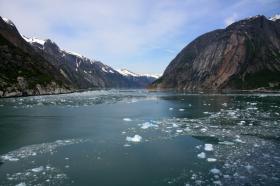Study relates influx of North American icebergs in Atlantic Ocean to increased methane production in tropical wetlands

A new study shows how huge influxes of fresh water into the North Atlantic Ocean from icebergs calving off North America during the last ice age had an unexpected effect – they increased the production of methane in the tropical wetlands.
Usually increases in methane levels are linked to warming in the Northern Hemisphere, but scientists who are publishing their findings this week in the journal Science have identified rapid increases in methane during particularly cold intervals during the last ice age.
These findings are important, researchers say, because they identify a critical piece of evidence for how the Earth responds to changes in climate.
“Essentially what happened was that the cold water influx altered the rainfall patterns at the middle of the globe,” said Rachael Rhodes, a research associate in the College of Earth, Ocean, and Atmospheric Sciences at Oregon State University and lead on the study, which was funded by the National Science Foundation. “The of tropical rainfall, which includes the monsoons, shifts to the north and south through the year.
“Our data suggest that when the icebergs entered the North Atlantic causing exceptional cooling, the rainfall was condensed into the Southern Hemisphere, causing tropical wetland expansion and abrupt spikes in atmospheric methane,” she added.
During the last ice age, much of North America was covered by a giant ice sheet that many scientists believe underwent several catastrophic collapses, causing huge icebergs to enter the North Atlantic – phenomena known as Heinrich events. And though they have known about them for some time, it hasn’t been clear just when they took place and how long they lasted.
Rhodes and her colleagues examined evidence from the highly detailed West Antarctic Ice Sheet Divide ice core (http://www.waisdivide.unh.edu). They used a new analytical method perfected in collaboration with Joe McConnell at the Desert Research Institute in Reno, Nevada, to make extremely detailed measurements of the trapped in the ice.
“Using this new method, we were able to develop a nearly 60,000-year, ultra-high-resolution record of methane much more efficiently and inexpensively than in past ice core studies, while simultaneously measuring a broad range of other chemical parameters on the same small sample of ice,” McConnell noted.
Continue reading at Oregon State University.
Mountain and ice image via Shutterstock.
2015©. Copyright Environmental News Network